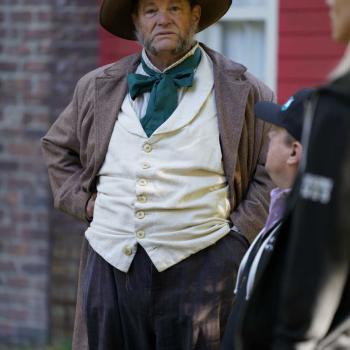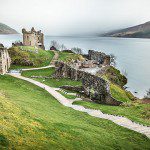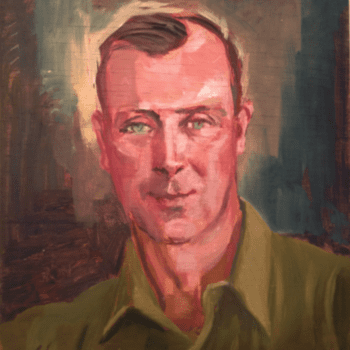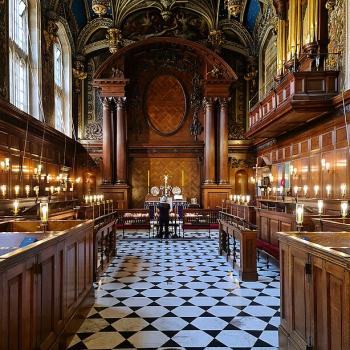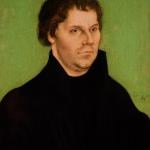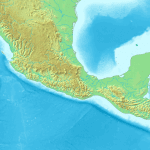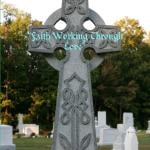[A recurring technical problem at Patheos has once again blocked my ability to post images here. I’ll share the appropriate photographs when and if I’m able.]
After I finished an article that was overdue and sent it off this morning, we headed up the road from Devils Lake to Rugby, North Dakota. A pillar there proclaims Rugby to be the geographical center of North America. One of my earliest memories — I think — is of my father taking a picture of me by that pillar when I was roughly four or five years old. Another nearby monument, several pillars of multi-colored metal, celebrates the aurora borealis, the famous Northern Lights. We then continued on nearly to the Canadian border, to the campus of Dakota College at Bottineau. DCB, as it’s known, was originally founded in 1906, pursuant to a provision of the state’s 1889 constitution, as the North Dakota School of Forestry. Its founding purpose was to foster the planting of trees on the Dakota prairies. (Today, so-called “shelter belts” of trees are prominent features of the local landscape.) We visited the school because my father studied forestry here for a while — I’m not quite sure how long, perhaps a year, or perhaps even two — just after graduating from high school early in the Great Depression. It’s still a very small campus, but I’m betting that it was tinier yet when my Dad was there, which must have been somewhere around 1929 or 1930 or perhaps shortly thereafter. Old Main, which announces on its facade that it was completed in 1906 (the year of the school’s opening), would obviously have been there while he was, and may well have been the only campus building in his day. He probably attended classes in it..
DCB and its predecessor, the North Dakota School of Forestry, have had some sort of relationship with the International Peace Garden, on the U.S./Canadian border. I don’t remember Bottineau from my visit to the Dakotas back when I was four or five, but I do recall — a vague memory, warm and positive — that we went to the International Peace Garden. I now realize that we must have gone because my father had a personal connection to it. I wanted to go again today, but our time this afternoon was somewhat limited and, anyway, the Canadian border is closed due to COVID-19 restrictions — and at least half of the Garden is in Canada. So we opted not to take the time. I regret that, though I think we had no other serious option.
Instead, we drove down to Starkweather, where my father was born and where he attended a one-room school. It was considerably smaller than I had I had expected it to be — population 117 in the 2010 census, which one source says makes it the third largest city in Ramsey County — and, frankly, it stirred no memories at all. Not even from my second (and immediately previous visit to North Dakota, when I was about seventeen or so). As for this trip, I had little or no time to prepare, but I had remembered, or seemed to remember, that my father had graduated from high school there. But maybe I’ve been wrong. Maybe his high school was here in Devils Lake, instead. Starkweather seemed both too small and too close to home. (I’ll explain why in a subsequent blog entry, perhaps.)
From Starkweather, we drove back to Devils Lake. Along the way, though, we stopped at Garske. As I understand it, my grandparents’ farm was somewhere in the vicinity of Garske. That’s where my father (and my paternal aunts and uncles) grew up. But it’s really hard to see where Garske is, or was. There is a roadside sign saying Garske that points to a complex of grain silos. A couple of houses stand just behind the grain silos. And that’s it. No streets. No town.
It’s frankly amazing to me that my father emerged from such places and such times, to become a non-commissioned officer in the Eleventh Armored Division of General Patton’s Third Army, to participate in the liberation of the Nazi concentration camp at Mauthausen and its satellite camp at Gusen, to finish the Second World War in Paris, to become (with one of his brothers) a successful contractor and small businessman in southern California, to join the Church of Jesus Christ of Latter-day Saints relatively late in his life and serve in a bishopric, and on and on and on. It’s amazing to me that my grandmother came over at the age of eighteen from a farm on the beautiful shore of the Kjøsnesfjord in Norway, at the foot of the largest glacier in Europe, to live as a farm wife on the North Dakota prairie. I never knew my paternal grandfather — nor, for that matter, my maternal grandfather — but it’s good to see the land that he worked. I heard stories about him.
But I would have loved to hear more. I have so many questions now! I vowed that it would not happen to me, but it did; I missed the chance to interview my father because his health plummeted suddenly and unexpectedly and it was no longer possible for him to remember. So, gor those of you who still have living parents or grandparents, here’s some fervent advice: Ask them all the questions that you possibly can. Interview them. And write down what they tell you, or record it. Then go through it and try to turn it into a coherent story; you’ll find that there are gaps in the stories and in your understanding of them. Then go back and do further interviews. And then repeat the process. Sooner than you expect, perhaps, the opportunity will be past, forever gone. And write your own history. Not “someday.” Start doing it now. At least get the basic chronology and story line down. It’s one of the very best gifts that you could possibly give to your children or other family members.
Posted from Devil’s Lake, North Dakota



